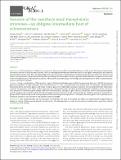Files in this item
Genome of the rams horn snail Biomphalaria straminea : an obligate intermediate host of schistosomiasis
Item metadata
| dc.contributor.author | Nong, Wenyan | |
| dc.contributor.author | Yu, Yifei | |
| dc.contributor.author | Aase-Remedios, Madeleine Emma | |
| dc.contributor.author | Xie, Yichun | |
| dc.contributor.author | So, Wai Lok | |
| dc.contributor.author | Li, Yiqian | |
| dc.contributor.author | Wong, Cheuk Fung | |
| dc.contributor.author | Baril, Toby | |
| dc.contributor.author | Law, Sean | |
| dc.contributor.author | Lai, Sheung Yee | |
| dc.contributor.author | Haimovitz, Jasmine | |
| dc.contributor.author | Swale, Thomas | |
| dc.contributor.author | Chen, Shan-shan | |
| dc.contributor.author | Kai, Zhen-peng | |
| dc.contributor.author | Sun, Xi | |
| dc.contributor.author | Wu, Zhongdao | |
| dc.contributor.author | Hayward, Alexander | |
| dc.contributor.author | Ferrier, David Ellard Keith | |
| dc.contributor.author | Hui, Jerome | |
| dc.date.accessioned | 2022-02-23T15:30:14Z | |
| dc.date.available | 2022-02-23T15:30:14Z | |
| dc.date.issued | 2022-02-15 | |
| dc.identifier | 277632798 | |
| dc.identifier | 69ac0a96-4a29-4587-a7c7-43d2302952ae | |
| dc.identifier | 85125473641 | |
| dc.identifier | 000809313900004 | |
| dc.identifier.citation | Nong , W , Yu , Y , Aase-Remedios , M E , Xie , Y , So , W L , Li , Y , Wong , C F , Baril , T , Law , S , Lai , S Y , Haimovitz , J , Swale , T , Chen , S , Kai , Z , Sun , X , Wu , Z , Hayward , A , Ferrier , D E K & Hui , J 2022 , ' Genome of the rams horn snail Biomphalaria straminea : an obligate intermediate host of schistosomiasis ' , GigaScience , vol. 11 , giac012 . https://doi.org/10.1093/gigascience/giac012 | en |
| dc.identifier.issn | 2047-217X | |
| dc.identifier.other | ORCID: /0000-0003-3247-6233/work/108508342 | |
| dc.identifier.uri | https://hdl.handle.net/10023/24942 | |
| dc.description | This work was supported by the Hong Kong Research Grant Council Collaborative Research Fund (C4015-20EF), General Research Fund (14100919), NSFC/RGC Joint Research Scheme (N_CUHK401/21), and The Chinese University of Hong Kong Direct Grant (4053433, 4053489). Y.Y., W.L.S., C.F.W., S.T.S.L., and Y.L. were supported by the Ph.D. studentships of The Chinese University of Hong Kong. A.H. is supported by a Biotechnology and Biological Sciences Research Council (BBSRC) David Phillips Fellowship (BB/N020146/1). T.B. is supported by a studentship from the Biotechnology and Biological Sciences Research Council-funded South West Biosciences Doctoral Training Partnership (BB/M009122/1). M.E.A.R. is supported by a Ph.D. studentship from the School of Biology and St Andrews University. | en |
| dc.description.abstract | Background: Schistosomiasis, or bilharzia, is a parasitic disease caused by trematode flatworms of the genus Schistosoma. Infection by Schistosoma mansoni in humans results when cercariae emerge into water from freshwater snails in the genus Biomphalaria and seek out and penetrate human skin. The snail Biomphalaria straminea is native to South America and is now also present in Central America and China, and represents a potential vector host for spreading schistosomiasis. To date, genomic information for the genus is restricted to the neotropical species Biomphalaria glabrata. This limits understanding of the biology and management of other schistosomiasis vectors, such as B. straminea. Findings: Using a combination of Illumina short‐read, 10X Genomics linked‐read, and Hi‐C sequencing data, our 1.005 Gb B. straminea genome assembly is of high contiguity, with a scaffold N50 of 25.3 Mb. Transcriptomes from adults were also obtained. Developmental homeobox genes, hormonal genes, and stress-response genes were identified, and repeat content was annotated (40.68% of genomic content). Comparisons with other mollusc genomes (including Gastropoda, Bivalvia, and Cephalopoda) revealed syntenic conservation, patterns of homeobox gene linkage indicative of evolutionary changes to gene clusters, expansion of heat shock protein genes, and the presence of sesquiterpenoid and cholesterol metabolic pathway genes in Gastropoda. In addition, hormone treatment together with RT-qPCR assay reveal a sesquiterpenoid hormone responsive system in B. straminea, illustrating that this renowned insect hormonal system is also present in the lophotrochozoan lineage. Conclusion: This study provides the first genome assembly for the snail B. straminea and offers an unprecedented opportunity to address a variety of phenomena related to snail vectors of schistosomiasis, as well as evolutionary and genomics questions related to molluscs more widely. | |
| dc.format.extent | 13 | |
| dc.format.extent | 3994087 | |
| dc.language.iso | eng | |
| dc.relation.ispartof | GigaScience | en |
| dc.subject | QH301 Biology | en |
| dc.subject | QH426 Genetics | en |
| dc.subject | QR Microbiology | en |
| dc.subject | DAS | en |
| dc.subject | SDG 3 - Good Health and Well-being | en |
| dc.subject.lcc | QH301 | en |
| dc.subject.lcc | QH426 | en |
| dc.subject.lcc | QR | en |
| dc.title | Genome of the rams horn snail Biomphalaria straminea : an obligate intermediate host of schistosomiasis | en |
| dc.type | Journal article | en |
| dc.contributor.institution | University of St Andrews. School of Biology | en |
| dc.contributor.institution | University of St Andrews. St Andrews Bioinformatics Unit | en |
| dc.contributor.institution | University of St Andrews. Centre for Biophotonics | en |
| dc.contributor.institution | University of St Andrews. Marine Alliance for Science & Technology Scotland | en |
| dc.contributor.institution | University of St Andrews. Scottish Oceans Institute | en |
| dc.identifier.doi | 10.1093/gigascience/giac012 | |
| dc.description.status | Peer reviewed | en |
| dc.identifier.url | https://academic.oup.com/gigascience/article/doi/10.1093/gigascience/giac012/6528774?searchresult=1 | en |
This item appears in the following Collection(s)
Items in the St Andrews Research Repository are protected by copyright, with all rights reserved, unless otherwise indicated.

